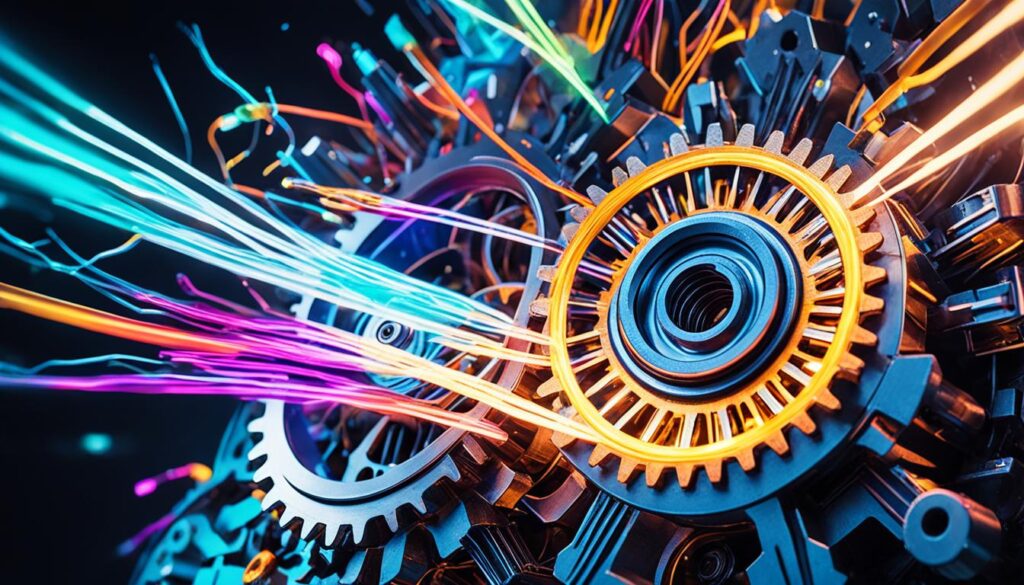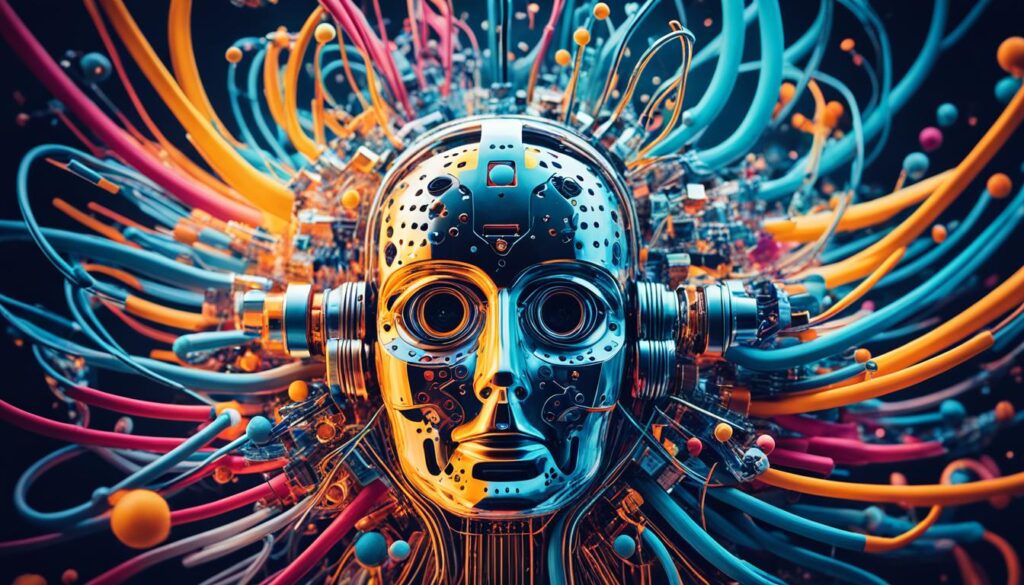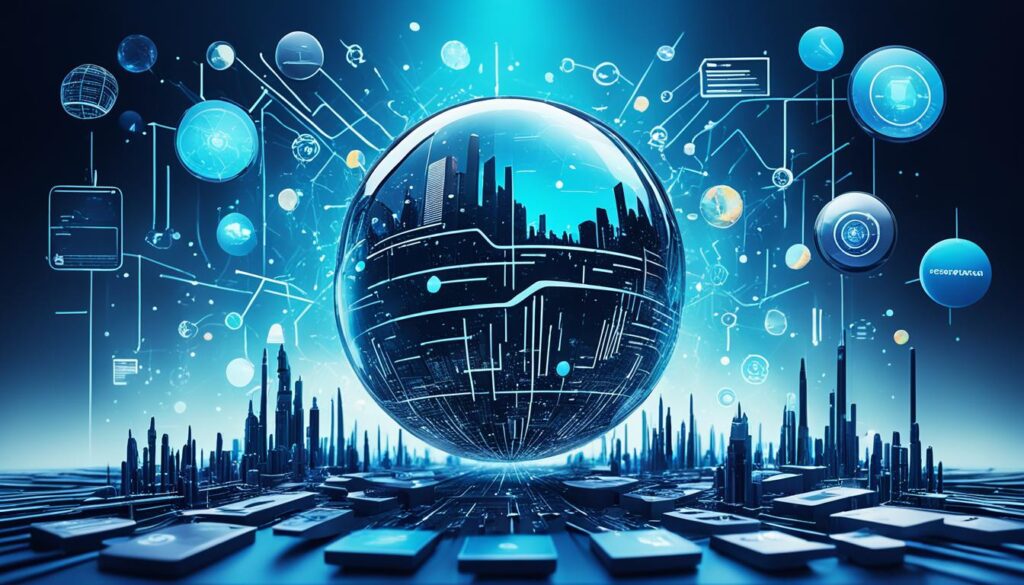We’re in the middle of a visual revolution, thanks to artificial intelligence (AI). This technology has changed how we make and use visual content. Now, AI tools help create everything from realistic photos to amazing digital art. They make the creative process easier for artists, designers, and marketers.
This article will look at the best AI tools changing the creative world. We’ll talk about the newest text-to-image AI models. We’ll also discuss the good and bad sides of AI visuals and the ethical issues they bring up. Our goal is to give you a deep look at AI in visual content creation.
Key Takeaways
- Discover the latest advancements in AI-powered visual content creation tools
- Understand the benefits and challenges of incorporating AI into the creative process
- Explore the ethical considerations surrounding the use of AI-generated visuals
- Gain insights into the potential future of AI in visual content creation
- Learn about the top AI visual content generators and their unique features
Introduction to AI-Generated Visual Content
The creative world is changing fast, thanks to AI. This new tech is changing how we make, enjoy, and use visual media.
The Rise of AI in Creative Industries
Text-to-image AI and generative AI art are becoming big in the creative world. These ai art generators help artists, designers, and marketers be more creative and efficient.
Benefits and Challenges of AI-Generated Visuals
Using image generation models has many benefits. It makes content more personal, speeds up work, and lets more people create visuals. But, there are also challenges. People worry about losing the human touch, jobs, and ethical issues with AI.
| Benefits of AI-Generated Visuals | Challenges of AI-Generated Visuals |
|---|---|
|
|
Exploring AI-generated visual content shows its big potential and challenges. Next, we’ll look at the best AI visual content generators and how they’re used.

Top AI Visual Content Generators
AI has changed how we make visual content. Tools like text-to-image generators and generative design platforms are leading this change. They let us create and interact with visuals in new ways.
Unleashing Creativity with AI Art Platforms
DALL-E 2, Midjourney, and Stable Diffusion are changing the game in AI art. These visual ai tools turn text into stunning images. They use machine learning to mix and create visual elements, leading to unique and surprising results.
Generative Design for Designers and Marketers
Canva and Adobe Sensei are great for designers and marketers. They use ai art platforms to make design faster and more creative. By automating the design process, they save time and encourage more creative experimentation.
These top ai visual content generators are opening up new possibilities for creative content. The use of AI in creative fields is exciting. It’s changing how we make, view, and interact with visual content.

“AI-powered visual content generators are opening up a new frontier of creative expression, allowing us to explore the boundaries of what’s possible in the digital realm.”
Exploring Text-to-Image AI Models
AI-generated visuals have made huge strides in recent years, especially with text-to-image AI models. These models have changed how we make and use visual content. They mix language and images in new ways. Let’s look at how these models work and what makes them special.
Understanding the Technology Behind Text-to-Image AI
Text-to-image AI models use natural language processing (NLP) and machine learning. They take text, understand its meaning, and then make an image from it. This is done with advanced tech like transformer-based models and generative adversarial networks (GANs).
These models learn from huge amounts of text and image data. They figure out how words and images are connected. This lets them make images that match the text well.
Image generation models have made big leaps in recent years. They use ai image synthesis to make realistic and varied images from text. This opens new doors for creativity and making visual content.
The future of text-to-image AI looks bright. We’ll see better accuracy, more variety, and easier use of these technologies. They could change how we see everything from realistic photos to art, affecting many fields like art and marketing.
AI Art Generators for Creative Expression
In the fast-changing world of creative tech, ai art generators are changing the game for artists and creatives. These tools let us explore new ways to make art. They blend human creativity with tech’s precision and flexibility.
Generative ai art and AI-made illustrations and animations are just the start. These creative ai software solutions are amazing. They use machine learning and AI to let artists and designers go beyond what was thought possible.
The growth of ai art generators is big news for art and design’s future. Some worry about AI’s role in art, but these tools boost human creativity, not replace it. They work with artists to open new doors in expression, showing us art’s endless potential.
Looking into creative ai software, we see a future where visual storytelling and design change. AI tech in creative work can change what we think is possible. It inspires artists and designers to be more creative than ever.
| AI Art Generator | Key Features | Use Cases |
|---|---|---|
| Midjourney |
|
|
| DALL-E 2 |
|
|
| Stable Diffusion |
|
|
Exploring ai art generators shows us a new era in creative expression. By using these generative ai art technologies, artists and designers can expand their craft. This lets creative ai software grow in new ways.
Generative AI Tools for Designers and Marketers
Designers and marketers are finding new allies in generative AI tools. These tools, using advanced image generation models, are changing how we make visual content.
Unleashing Creativity with AI Image Synthesis
Generative AI tools are making automated design, product visualization, and personalized content creation easier. Visual ai tools and ai art platforms use image generation models to make unique visuals. These visuals meet the changing needs of businesses and consumers.
AI image synthesis tools help streamline work and boost productivity. They automate repetitive tasks, letting designers focus on strategy and creativity. This helps designers reach their full potential.
- Automated Design Generation: Generative AI tools create custom designs and campaigns, saving time and resources.
- Product Visualization: These tools make realistic product images, helping customers see and interact with products before buying.
- Content Personalization: Generative AI tailors visuals to what users like, making content more engaging and relevant.
| Use Case | Benefits | Examples |
|---|---|---|
| Automated Design Generation | Increased efficiency, consistent branding, scalable content creation | Canva, Adobe Sensei, Midjourney |
| Product Visualization | Improved customer experience, reduced costs, streamlined workflows | Klarna, Shopify AR, 3D Warehouse |
| Content Personalization | Enhanced user engagement, targeted marketing, data-driven decision-making | Persado, Optimizely, Sitecore |
Generative AI is getting more powerful, and designers and marketers are using it to be more creative and efficient. They’re making visuals that are more compelling and impactful for their audiences.
Ethical Considerations in AI-Generated Visuals
The use of ai art generators and generative ai art is growing fast. This brings up big questions about ethics. Image generation models offer new creative chances but also worry about rights, bias, and how they affect human creativity.
One big worry is about who owns the art made by ai art generators. This question is hard because old ideas of who makes art are changing. It’s making people argue a lot.
Generative ai art might show and spread biases if the data used to make it is biased. This could mean the art might not show everyone fairly. Making sure ai art generators are fair and include everyone is very important.
Also, how open the ai art generator process is has become a big topic. As people use generative ai art more, they need to know how AI helps make the art. Being open helps people trust the tech more.
As ai art generators get better, we need to think carefully about these big issues. We should work on solving problems with rights, bias, and being open. This way, we can make sure image generation models are right and don’t hurt human creativity.
| Ethical Consideration | Key Challenges | Proposed Solutions |
|---|---|---|
| Intellectual Property Rights | Ownership of AI-generated visuals, potential for infringement | Establish clear guidelines and legal frameworks around ownership and attribution |
| Bias and Fairness | Perpetuation of societal biases in training data, lack of diversity in outputs | Implement robust bias detection and mitigation strategies, diversify training data |
| Transparency | Unclear understanding of the role of AI in the creative process | Provide clear disclosure and explanations about the AI’s involvement in visual content creation |
By tackling these big issues, we can make sure ai art generators are used right. This way, generative ai art can open up new creative doors. And we can keep human creativity safe and protect basic rights.
The Future of AI in Visual Content Creation
Visual content creation is changing fast, and AI is playing a big role. AI is making tools that help create images, making it hard to tell them apart from real ones. This change is exciting and will change how we make and use visual content.
Integrating AI with Emerging Technologies
AI is teaming up with new tech like AR and VR to change how we make visuals. This mix will create immersive and personal experiences. AI will get better at knowing what people like, making content just for them.
Advancements in Generative Models
Generative AI models are getting better at making images from text or other pictures. This means creators can make high-quality images easily and quickly. These models will also create new ways for people to interact with visuals, mixing the real and the imagined.
Implications for Various Industries
AI will change many industries, like marketing, entertainment, and education. Companies will use AI to make content that speaks to people directly. Creative people will use AI to improve their work and work together better. AI will also create new jobs that need special skills.
As AI changes visual content, we must think about its ethics and effects on society. We need to make sure AI helps creativity, not replaces it. The mix of human and machine will unlock AI’s full potential in visual content.
Unleashing Creativity with AI Image Synthesis
AI art generators and generative AI art tools are changing how we make visual content. They let artists, designers, and creatives go beyond what’s possible. From surreal scenes to super-real images, these tools help us create amazing things.
Adding creative AI software to our work has started a new chapter in art. Machine learning algorithms in these tools make unique and eye-catching visuals. They go beyond what traditional art can do.
AI-powered image synthesis works well with human creators. It doesn’t replace us but helps us more. By mixing human creativity with AI’s power, we open up new ways to explore and try new things.
We can make photorealistic views of dream worlds or surreal scenes. Generative AI art lets us dive into the fantastical, the abstract, and the unexpected. It opens up new possibilities in art.
As image generation models and creative AI software get better, visual content creation is set to become more exciting and innovative. AI in art not only opens new ways to express ourselves. It also brings humans and machines together, starting a new era of artistic discovery.
“AI-powered image synthesis is transforming the creative landscape, allowing us to transcend the boundaries of traditional art and explore the limitless realms of the imagination.”
Best Practices for Using AI Visual Content Generators
As AI visual content generators grow in popularity, we need to use them wisely. It’s important to balance their power with ethical standards. This ensures we get the most out of these technologies without losing our moral compass.
First, it’s key to know what AI visual content generators can and can’t do. They’re powerful, but they can’t replace human creativity. By working together with humans, we can use the best of both worlds to make amazing visuals.
- Ensure transparency and attribution: Always be clear about how you made your visuals and give credit to the AI system.
- Maintain ethical standards: Stick to ethical rules and don’t use AI-generated content in ways that could trick or mislead people.
- Continuously educate and upskill: Keep up with the latest in AI visual content generation and change your methods as needed.
By following these best practices, we can use AI visual content generators and tools to make stunning and effective content. We also keep our work transparent, ethical, and innovative.
Success with AI visual content generators comes from knowing what they can do, working with human expertise, and staying ethical. With the right strategy, we can fully benefit from these technologies and improve visual content creation.
Top AI Visual Content Generators: A Comparative Analysis
AI-powered visual content generators are changing the game in creative tools. They range from turning text into images to creating art. We’ve looked at the best ones to help you pick the right one.
Evaluating Features and Performance
Not all AI visual content generators are the same. Each has its own set of features and how well it performs. We looked at several important factors to help you choose:
- Image Quality: It’s crucial to get visuals that look good and match what you want. We checked how well these AI tools do in this area.
- Versatility: Great AI tools can work on many projects, from product pictures to art.
- Ease of Use: Tools that are easy to use make adding them to your creative work easier.
- Customization Options: Being able to change the visuals to fit your needs is important.
- Speed and Efficiency: Fast image making and optimizing is key for meeting deadlines and staying productive.
We looked at these important points to highlight the best and worst of the top ai visual content generators, image creation ai, and ai art platforms. This gives our readers a clear guide to picking the right tool for their projects.
“The future of visual content creation is undoubtedly AI-driven. Understanding the nuances and capabilities of these cutting-edge tools is key to unlocking their full potential.”
Conclusion
As we wrap up our look at AI-powered visual content generators, it’s clear this tech could change the game. AI models like text-to-image and generative AI tools are opening new doors for designers, marketers, and artists.
The future of AI in making visuals is thrilling and makes us think. We’ve seen how AI can boost creativity, make design easier, and open new ways to tell stories. But, we must use these tools wisely, thinking about the ethical sides, like protecting ideas and keeping media real.
As AI visual content makers get better, we need to keep up with new tech and talk about using it right. By using AI’s power and sticking to ethical standards, we can fully tap into AI-generated visuals. This will help shape the future of making visual content.
